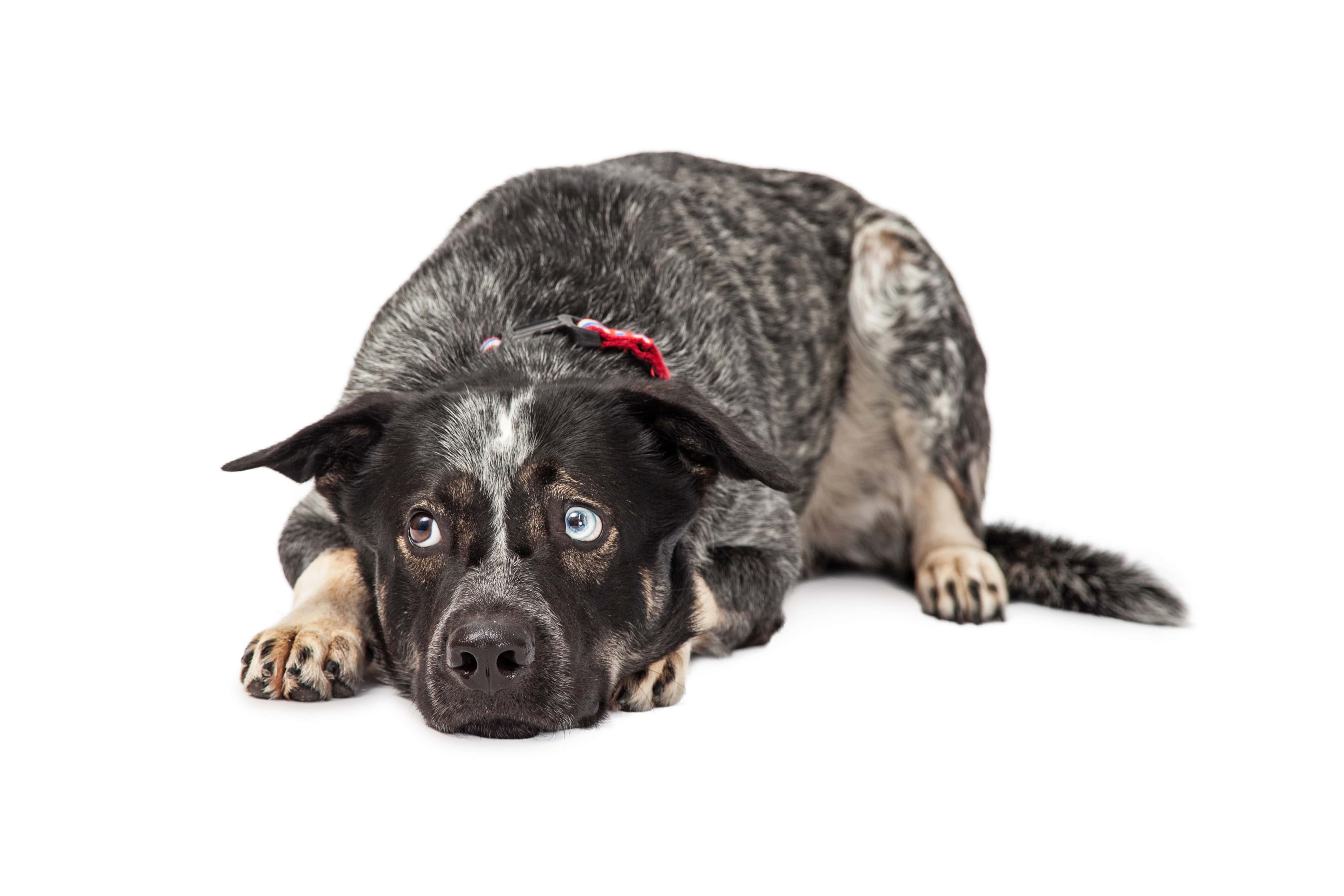
Anxiety in dogs can be distressing for both pets and owners. This guide covers how to identify anxiety in dogs, common triggers, and ways to help manage their stress effectively. You’ll learn about symptoms, triggers, and practical strategies for calming your anxious dog.
Key Takeaways
-
Recognizing anxiety symptoms, such as excessive barking, pacing, shaking, drooling, and panting, is crucial for pet owners to effectively address their dog’s discomfort.
-
Common triggers for dog anxiety include separation from owners, loud noises, and new environments; identifying these allows for better management of the dog’s stressors.
-
Effective strategies to calm anxious dogs include regular exercise, creating a safe space, positive reinforcement training, and considering natural remedies or veterinary consultation when necessary.
Recognizing Anxiety in Dogs

Dogs typically show clear signs of anxiety. It is usually easy to recognize their discomfort. Over 70% of dogs exhibit at least one behavior related to anxiety, making it a common issue for many pet owners. Identifying anxiety symptoms in your dog is the initial step in making them more comfortable.
An anxious dog may show a variety of physical and behavioral signs. These can include excessive barking, pacing, shaking, drooling, and panting. Your dog’s body language can offer insights into their emotional state. For example, a lowered tail, raised hackles, or a stiff posture can indicate unease in your dog’s body.
In the following subsections, we’ll delve deeper into specific signs of anxiety, helping you better understand what to look for and how to interpret these normal behaviors.
Excessive Barking
For many dogs, barking excessively is a key signal of stress or anxiety. This behavior can be particularly noticeable when the dog is exposed to triggers such as loud noises or unfamiliar environments. Noticing excessive barking is important for pet owners to understand their dog’s emotional state and offer support.
An anxious dog may bark excessively at seemingly insignificant stimuli, which can be a clear indicator of distress. This type of behavior is common in anxious dogs and can be accompanied by other signs of discomfort, such as whining or a tense posture. Recognizing these signs enables you to address the root cause of your pet’s anxiety more effectively.
Pacing and Shaking
Pacing and shaking are common physical signs of anxiety in dogs. An anxious dog may pace back and forth or shake uncontrollably. This can often be a response to specific stressors, such as loud noises or unfamiliar environments.
These behaviors indicate that the dog is feeling worried or nervous and are often accompanied by other signs of distress, such as cowering or tail tucking. Recognizing these behaviors allows pet owners to remove the stressor and ensure their dog’s comfort and safety.
Drooling and Panting
Increased drooling and panting are also common signs of a dog’s anxiety. These physiological responses can occur when a dog is stressed or nervous. Panting without any physical activity is often a clear indicator of stress, as it signifies that the dog is experiencing an increased heart rate and heightened anxiety.
Keeping an eye on excessive drooling helps pet owners identify and address their dog’s anxiety more effectively. Recognizing these signs allows you to alleviate your dog’s discomfort and create a calming environment.
Common Triggers for Dog Anxiety

Identifying the source of your dog’s anxiety is crucial for effective treatment. Common triggers for dogs’ anxiety include abandonment, fear of being alone, loud noises, traveling, and exposure to unfamiliar people or pets. Recognizing your dog’s anxiety triggers allows you to manage and mitigate these stressors.
Common triggers for dogs’ anxiety include:
-
Abandonment
-
Fear of being alone
-
Loud noises
-
Traveling
-
Exposure to unfamiliar people or pets
Recognizing your dog’s anxiety triggers allows you to manage and mitigate these stressors.
Different dogs may have different triggers. For some, it could be separation from their owner, while for others, it might be loud noises like fireworks or thunderstorms. Recognizing these triggers and their impact on your dog can significantly aid in managing their anxiety.
In the following subsections, we’ll explore specific common triggers such as separation anxiety, loud noises, and new environments, providing insights into how these situations can impact your dog and what you can do to help.
Separation Anxiety
Separation anxiety in dogs involves abnormal reactions when away from their owner, often due to being left alone. This can manifest in behaviors such as excessive barking, whining, or destructive actions like chewing furniture or digging. These signs indicate that the dog is experiencing significant distress and fear when separated from their owner.
Creating a calm, quiet space with familiar items and safe toys can help a dog with separation anxiety. Using praise and small treats when returning after short absences can also help reduce the dog’s anxiety. Gradually increasing time apart can make your dog feel more secure when alone.
Loud Noises
Many dogs develop intense fears related to loud sounds like thunder or fireworks. These loud noises can trigger significant anxiety, leading to behaviors such as barking excessively, whining, or hiding. The sudden and unpredictable nature of these sounds can cause panic in dogs, making them feel unsafe.
Providing a quiet space for your dog to retreat during these events can alleviate their anxiety. Offering comfort and reassurance during these times helps your dog feel secure and protected from distressing noises.
New Environments
Dogs can develop anxiety from new people, dogs, or objects, especially when introduced to unfamiliar environments. Moving to a new house or other changes in surroundings can be particularly stressful for dogs. This anxiety can manifest in behaviors such as excessive barking, pacing, or hiding.
Providing stability and familiarity helps your dog adjust to new environments. Bringing favorite toys or items that smell like home can ease the transition and make your dog more comfortable in new surroundings.
Effective Strategies to Calm an Anxious Dog
Combining various strategies can help reduce an anxious dog’s stress and promote a sense of security. Regular exercise, creating a safe space, and positive reinforcement training are effective strategies. These methods can significantly alleviate your dog’s anxiety and improve their overall well-being.
Regular play and exercise can help reduce hyperactivity and promote calmness. A consistent routine can also make your dog feel more secure and less anxious. Grooming and physical contact with the owner can also provide comfort and relaxation.
In the following subsections, we’ll delve into specific strategies such as exercise and physical activity, creating a safe space, and positive reinforcement training to help calm your anxious dog.
Exercise and Physical Activity
Regular physical exercise helps decrease hyperactivity and promote calmness in dogs. Activities such as the Coaching Calm game or the Go to Mat exercise can teach dogs to relax and settle down by rewarding calm behavior. Positive reinforcement during training helps dogs learn to maintain calm body language.
Watching your dog’s body language ensures they are genuinely calm during training. Gradually introducing calm training methods, focusing on small distractions, helps your pet cope with stress in a controlled manner.
Creating a Safe Space
A designated safe space acts as a calming retreat for anxious dogs. Including a comfortable bed, a favorite blanket, and food toys in this space can make your dog feel secure and relaxed. A quiet space calms nerves and offers your dog a safe retreat from stressful situations.
When your dog retreats to their safe space, it’s suggested to give them treats and affection to reinforce the positive association. A safe environment can significantly reduce your dog’s anxiety and provide a sense of security.
Positive Reinforcement Training
Positive reinforcement in training involves teaching with praise and rewards for desired behavior. The goal is to teach anxious dogs to settle down or retreat to a safe place by developing a reward program and teaching calm tasks first. Obedience training can help anxious dogs manage stress and feel more secure in anxious situations.
Practicing commands to distract the dog and provide normalcy during anxious moments is key for effective training. Focus training on getting the dog to make eye contact or focus on a treat/toy to reinforce positive behavior. Training your pet when they’re calm and rested maximizes effectiveness.
Natural Remedies for Dog Anxiety
Dogs experiencing anxiety can benefit from various natural remedies, including the use of melatonin and lignans. Melatonin, a hormone produced by the pineal gland, helps regulate sleep-wake cycles and can promote calmness in dogs by reducing stress. Supplementing with melatonin has been shown to alleviate symptoms of anxiety, such as excessive pacing, panting, and whimpering.
Lignans, compounds found in plants like flaxseed, possess antioxidant properties and may support hormonal balance, potentially aiding in stress reduction. Combining melatonin with lignans can be particularly beneficial for dogs with conditions like Cushing's disease, as this combination may help lower cortisol levels and alleviate related symptoms.
Before introducing these supplements into your dog's regimen, it's essential to consult with a veterinarian to determine the appropriate dosage and ensure they are suitable for your pet's specific needs.
When to Consult a Veterinarian
Despite your best efforts, your dog’s anxiety might sometimes persist. Knowing when to seek professional help is key for effectively managing your dog’s anxiety. A veterinarian can offer a diagnosis and treatment recommendations tailored to your dog’s specific needs.
If persistent anxiety symptoms or health issues arise, consulting a veterinarian is advised. They can offer specialized treatment options and guide you through managing your dog’s anxiety.
We will discuss persistent anxiety symptoms, behavioral modification plans, and anti-anxiety medications as potential solutions for managing severe anxiety in dogs.
Persistent Anxiety Symptoms
Persistent anxiety symptoms in dogs can manifest in various ways, leading to significant distress. These symptoms may include constant pacing, excessive barking, destructive behavior, and changes in appetite or sleep patterns. Recognizing these signs is crucial for your dog’s well-being.
Consistent stress or medical concerns warrant professional help for tailored treatment options to address chronic stress and anxiety in stressed dogs. A veterinarian can help identify the underlying medical conditions and recommend effective strategies to manage your dog’s anxiety.
Behavioral Modification Plans
Veterinary behaviorists specialize in diagnosing and treating behavioral issues in dogs, especially anxiety, within the field of veterinary medicine. They can develop tailored treatment plans based on individual needs, considering the dog’s specific anxiety triggers and symptoms.
These custom plans may include a combination of behavior modification techniques, training, and possibly medication if necessary. Consulting a veterinary behaviorist can lead to more effective management of chronic anxiety, improving the overall quality of life for both the dog and owner.
Anti-Anxiety Medications
Prescription medications can manage conditions like separation anxiety and destructive behavior in dogs. The type and dosage of anti-anxiety medication will depend on the dog’s age, existing medical conditions, and specific anxiety triggers.
Summary
Recognizing and managing anxiety in dogs is a multi-faceted process that involves understanding the signs, identifying triggers, and implementing effective strategies. From excessive barking and pacing to drooling and panting, being aware of these symptoms can help you provide the necessary support for your anxious dog.
Implementing strategies such as regular exercise, creating a safe space, and using positive reinforcement training can significantly alleviate your dog’s anxiety. Additionally, natural remedies like melatonin and lignans can offer further relief. When anxiety symptoms persist, consulting a veterinarian for professional advice ensures your dog receives the best care possible.
With the right knowledge and tools, you can help your dog navigate their anxious moments and lead a happier, more relaxed life.
Frequently Asked Questions
What are the common signs of anxiety in dogs?
If your dog exhibits excessive barking, pacing, shaking, drooling, panting, or destructive behaviors, these could be common signs of anxiety. Addressing these symptoms promptly is crucial for their well-being.
How can I help my dog with separation anxiety?
To help your dog with separation anxiety, create a calm environment filled with familiar items and safe toys. Reinforce positive behavior with praise and small treats when returning after brief absences.
What natural remedies can help manage dog anxiety?
Lignans and melatonin supplements are effective natural remedies for managing dog anxiety. Consider incorporating these options to help your dog feel more relaxed and secure.
When should I consult a veterinarian for my dog's anxiety?
You should consult a veterinarian for your dog's anxiety if symptoms persist despite your efforts at home, or if they are linked to any health concerns. Taking timely action can help improve your dog's well-being.
How can positive reinforcement training help an anxious dog?
Positive reinforcement training helps anxious dogs by encouraging them to find comfort in safe spaces through praise and rewards, which aids in stress management. This method builds their confidence and fosters a more relaxed demeanor.
What is the dosage for melatonin for dogs?
The University of Tennessee College of Veterinary Medicine recommends, and the late Dr. Jack Oliver, DVM, former Chairman of UofT's Veterinary Endocrinology Department, recommended:
-
3 mg of melatonin (1 tablet) every 12 hours for dogs under 30 lbs.
-
6 mg of melatonin (2 tablets) every 12 hours for dogs over 30 lbs.
-
1 mg of melatonin (you may cut the tablet in half) every 12 hours may be recommended for dogs 10 lbs. or less, or for those who want to give their dogs very low doses of melatonin.
Check out our dosing calculator for more information.

1 commentaire
I have an 8 pound miniature schnauzer that is seven years old. He is very excitable and anxious even when we go to Petsmart I don’t know what to give him prior to taking him out to get him Use to going out with me. Please contact me and let me know the best thing for him that I could give him few Before I take him out I prefer to give him natural ingredients because he is very special to me and also he’s very delicate and sensitive to foods, etc. he has no allergies but he’s very very picky and spoiled. 😊